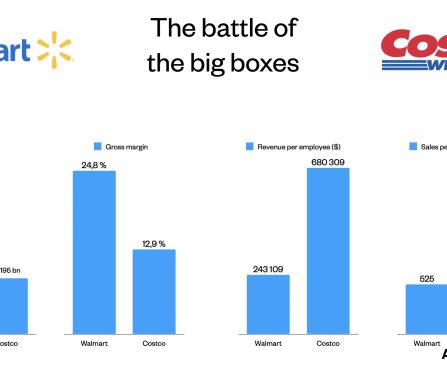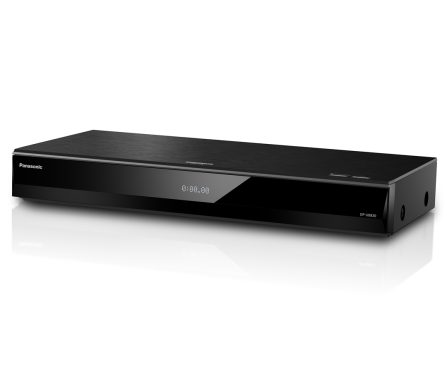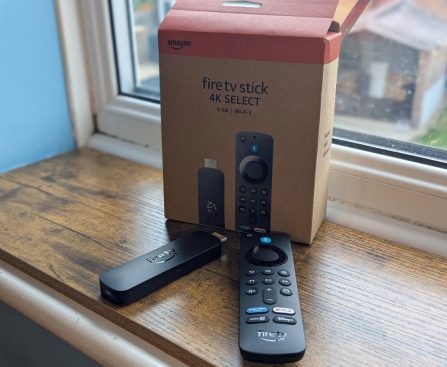the final iPod touch.
Blog Posts
Blog Posts
Clicks Creates a BlackBerry-Like Device to Tackle Smartphone Distraction
Clicks, a firm celebrated for its forward-thinking technology strategies, has rolled out a novel idea in the smartphone sector, underlining the significance of tactile feedback with actual buttons. During CES 2026, Clicks revealed its inaugural smartphone, the Communicator, crafted around a tactile QWERTY keyboard, intelligent notification features, and the cutting-edge Android 16 operating system. This gadget is not meant to replace your main smartphone but to act as a communication-centric companion.
The Communicator boasts a 4.03-inch AMOLED touchscreen, a 50MP OIS primary camera, a 24MP selfie camera, and a 4,000mAh battery with Qi2 wireless charging capabilities. Additionally, it includes a 3.5mm headphone jack, 5G connectivity, NFC for transactions, and expandable storage up to 2TB. The phone’s distinctive design features a fingerprint sensor embedded in the spacebar for instant unlocking and a customizable Signal LED for alerts.
Alongside the Communicator, Clicks has launched the Power Keyboard, a multifunctional 3-in-1 accessory that serves as a magnetic phone holder, a 2,150 mAh wireless backup power source, and a universal Bluetooth keyboard. This accessory can magnetically attach to gadgets using MagSafe or Qi2, offering 5W wireless charging while in use. It can toggle between three saved devices, making it a practical tool for a variety of electronics.
Clicks’ strategy emphasizes the persistent demand for physical buttons in a landscape dominated by touchscreen gadgets. The Communicator and Power Keyboard deliver a distinctive combination of contemporary technology and classic tactile feedback, appealing to those who prioritize effective communication and productivity. With introductory pricing commencing at $399 for the Communicator and $79 for the Power Keyboard, Clicks aims to transform the way we engage with our devices.
Reasons Behind Costco’s Lower Prices on TVs
mentioned in an interview a few years prior. “Our objective is consistently to negotiate enhanced specifications, extra warranties or streaming credits with well-known services like Paramount+, Showtime, and Xbox, to provide added value for our members.”
Moreover, since consumers do not frequently buy new television sets, competitively pricing them is an effective strategy to attract shoppers, who can then be marketed to for other electronics, alongside more affordable higher-margin products such as clothing and groceries. In conclusion, some of the television models available at the retailer are exclusive to Costco and are not found elsewhere. This creates an opportunity for the company to reduce prices without concerns about competing stores undermining their prices or instigating a price-matching competition.
Costco generates the majority of its revenue from memberships
Why Astute Buyers Prefer This Option Instead of Inexpensive Mini PCs
cost fluctuation challenges with PC components. This is largely attributed to companies requiring hardware capable of managing the substantial workloads resulting from the surge in artificial intelligence. While I believe that the mini-PC choice is excellent, particularly for individuals who primarily rely on their computers for simple tasks and media consumption, it is not suitable for everyone.
There are businesses with names that may be unfamiliar to you, promoting inexpensive mini-PCs featuring outdated specifications, inferior build quality, and mediocre support. This renders many of these mini-PCs inadequate for serious work or leisure activities. That’s where a compact computer like the Mac mini comes into play. This is as near to a genuine desktop PC substitute as we’ve encountered, equipped with sufficient performance to keep you operating efficiently for years.
The Mac mini provides enduring value
How to Change HDMI Inputs with Your Apple TV Remote
Apple TV 4K can also be configured to manage TV power and volume. This enhancement makes your overall TV viewing experience even more seamless, yet there’s one crucial TV feature that’s absent: input switching.
Although it’s not the most significant inconvenience to grab your TV remote for changing to another HDMI port or your TV’s antenna input, having fewer remotes is preferable. Luckily, if you don’t mind letting go of your Apple TV’s mute function, there’s a workaround to enable the input command on your Siri remote. This is one of several hidden features of Apple TV that everyone should be aware of, and the setup only takes a few moments.
To configure this, simply open Settings on your Apple TV 4K. Go to Remotes and Devices, then Volume Control, and select Learn New Device. Take your TV remote and follow the programming wizard as you would for the volume up and down buttons. When prompted to press the mute button, instead press and hold your TV remote’s input button.
Once the programming is set, pressing the mute button on your Apple TV remote will display your TV’s input dashboard. Press the button repeatedly to scroll through inputs. When you see the desired input, just keep it highlighted for a few seconds, and your TV should switch automatically.
Your Apple TV is already compatible with other remotes
Zack Snyder’s Underrated Zombie Movie Now Streamable on Netflix
a multitude of other remarkable films such as Liam Neeson’s overlooked action-packed thriller, “Honest Thief”.
What makes ‘Dawn of the Dead’ unique?
[embedded content]
Best 4K Blu-Ray Players Suggested for Film Enthusiasts
five top 4K Blu-ray films to enjoy on your new television.
Panasonic UB820-K
Achieving 4.3 out of 5 stars on Amazon — influenced by more than 1,900 reviews — the Panasonic UB820-K is a remarkable 4K Blu-ray player
Uncover Four Obscure Yet Essential TV and Streaming Applications
streaming platforms that justify your investment. You also have the choice to utilize free streaming applications to conserve funds as subscription prices continue to rise. Nevertheless, having trustworthy and valid channels for viewing content is merely part of the equation.
The true difficulty begins once you settle in to watch something. It’s quite common to spend more time browsing than actually viewing anything, as discovering your next “must-see” can prove challenging. Frequently, you may hear about a popular film or series, but you’re uncertain where it’s available for streaming or if it’s truly worth your valuable time. This is where tools like JustWatch and Marathon become essential.
These frequently disregarded applications provide significant value to your viewing experience, supplying detailed information that you won’t typically encounter on a regular streaming platform. Here are four TV and streaming applications that you should consider downloading on your smart TV or mobile device. We chose these applications after thoroughly evaluating their features, overall usefulness, and user reviews from the Android and iOS app stores.
Justwatch
Justwatch is an excellent application to discover where every film or television series is available for streaming. Just type in the title of the content you want to view, and it will indicate which streaming services are offering it in your region, or from where you can rent or purchase its digital version. However, this extraordinarily handy function is just the beginning of what Justwatch offers. It also reveals today’s trending selections across various streaming platforms and lists the latest additions to your chosen services. Furthermore, you can compile your own lists to monitor particular TV series and receive notifications when a new episode or season is released.
Additional features include content suggestions based on your viewing habits, alerts about which titles are set to leave certain services, or which are soon to be added. Beyond films and TV series, Justwatch can inform you whether you can watch your favorite sports live, such as football, soccer, tennis, basketball, and ice hockey. It has official applications available for all major platforms, including mobile devices and
Dollar Tree Provides Inexpensive Wooden Crate for Convenient Cable Organization at $1.25
all you truly require is a straightforward container of some sort to organize your items. While Dollar Tree may not be your first choice for storage options, it currently has a wooden crate featuring handles for your expanding collection of cables. Priced at just $1.25, the crate is compact enough to sit on a desk or a nearby shelf when you want to keep your cables accessible.
The price is unbeatable, and the natural wood is ideal for painting or staining
Dollar Tree’s wooden crate is not only basic but also adaptable. With dimensions of 3.15 inches wide, 5.5 inches long, and 2.36 inches tall, this storage unit is quite small, but it can be just the right fit for holding cables for your computer, printer, and other gadgets. Moreover, you can easily stack these crates if you need additional space for chargers, power adapters, USB drives, headphones, and spare batteries. Since they are crafted from wood, you can glue, nail, or screw them together to ensure they remain attached. You could even construct an entire wall of tiny crates, buying 24 of them for $30.
If you are in the mood for a DIY project, you can customize your workspace by staining or painting the crates, or by adding embellishments such as small charms or beads. Customer feedback on the Dollar Tree website tends to be positive, though
Enhance Your Smart Home Performance with This Efficient Fix
enhance your internet performance without spending on a new router or other accessories, one underappreciated method is setting up Virtual Local Area Networks (VLANs) to assist in organizing the devices on your Wi-Fi network. A VLAN enables you to divide a physical Wi-Fi network into several virtual networks, each with distinctive permissions and limitations. This means your frequently communicating smart bulbs, plugs, and sensors can operate on a separate path from bandwidth-intensive devices such as computers and smart TVs. Rather than every device competing for bandwidth, the data flow is more effectively managed — resulting in improved overall network efficiency.
Luckily, configuring a VLAN doesn’t necessitate additional cabling or substantial network changes — all you need to do is access your router’s admin panel to perform some digital tidying up.










